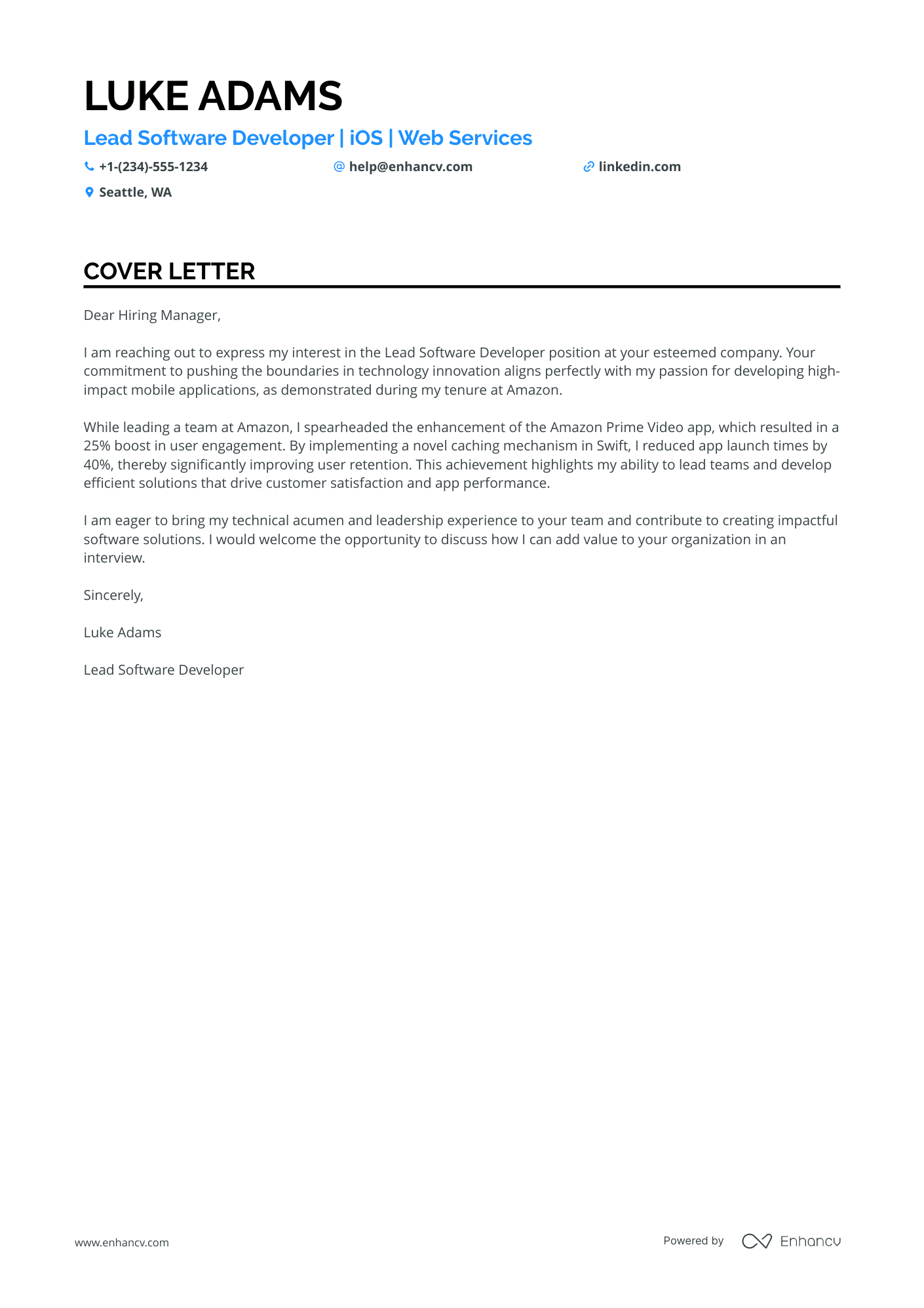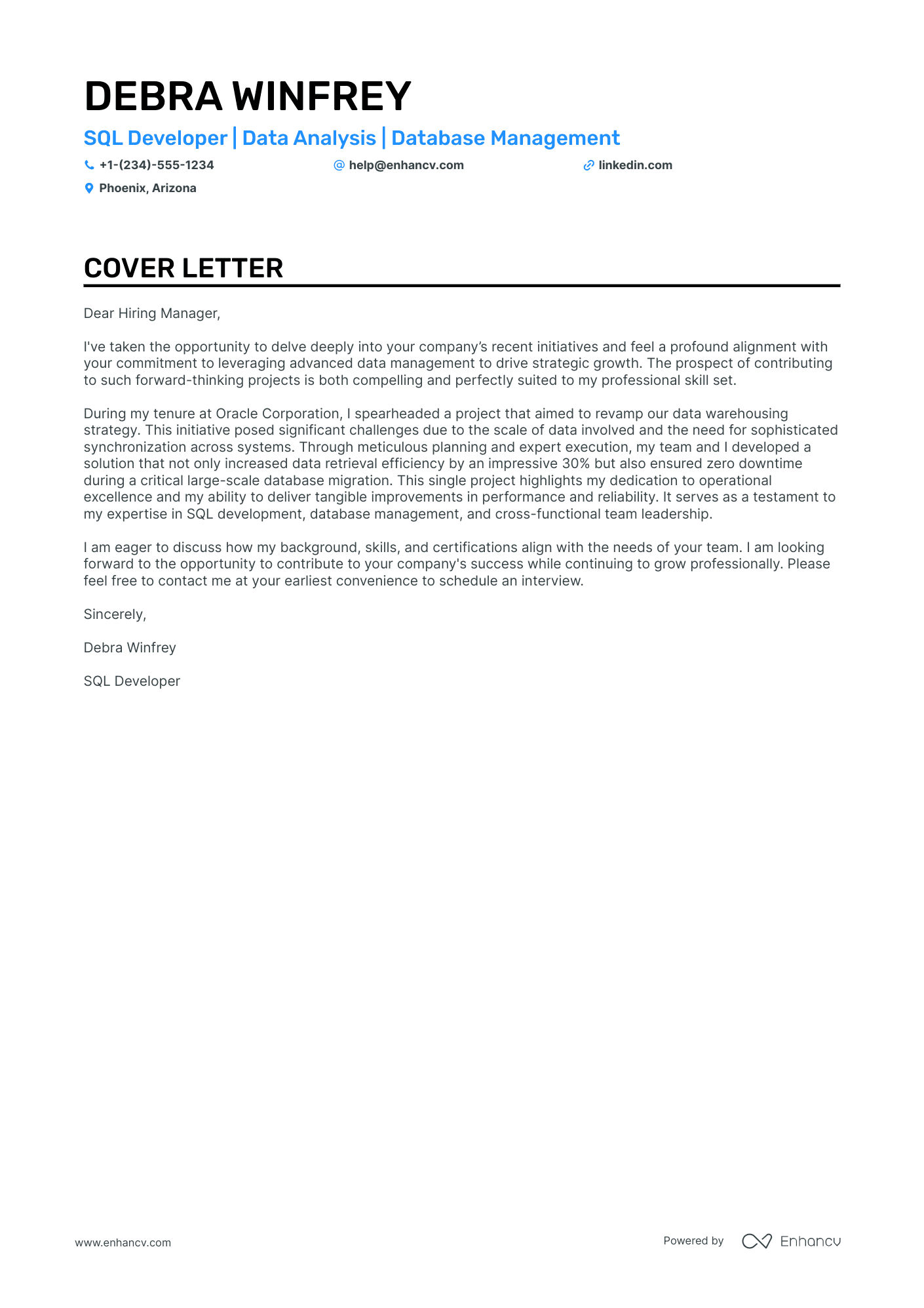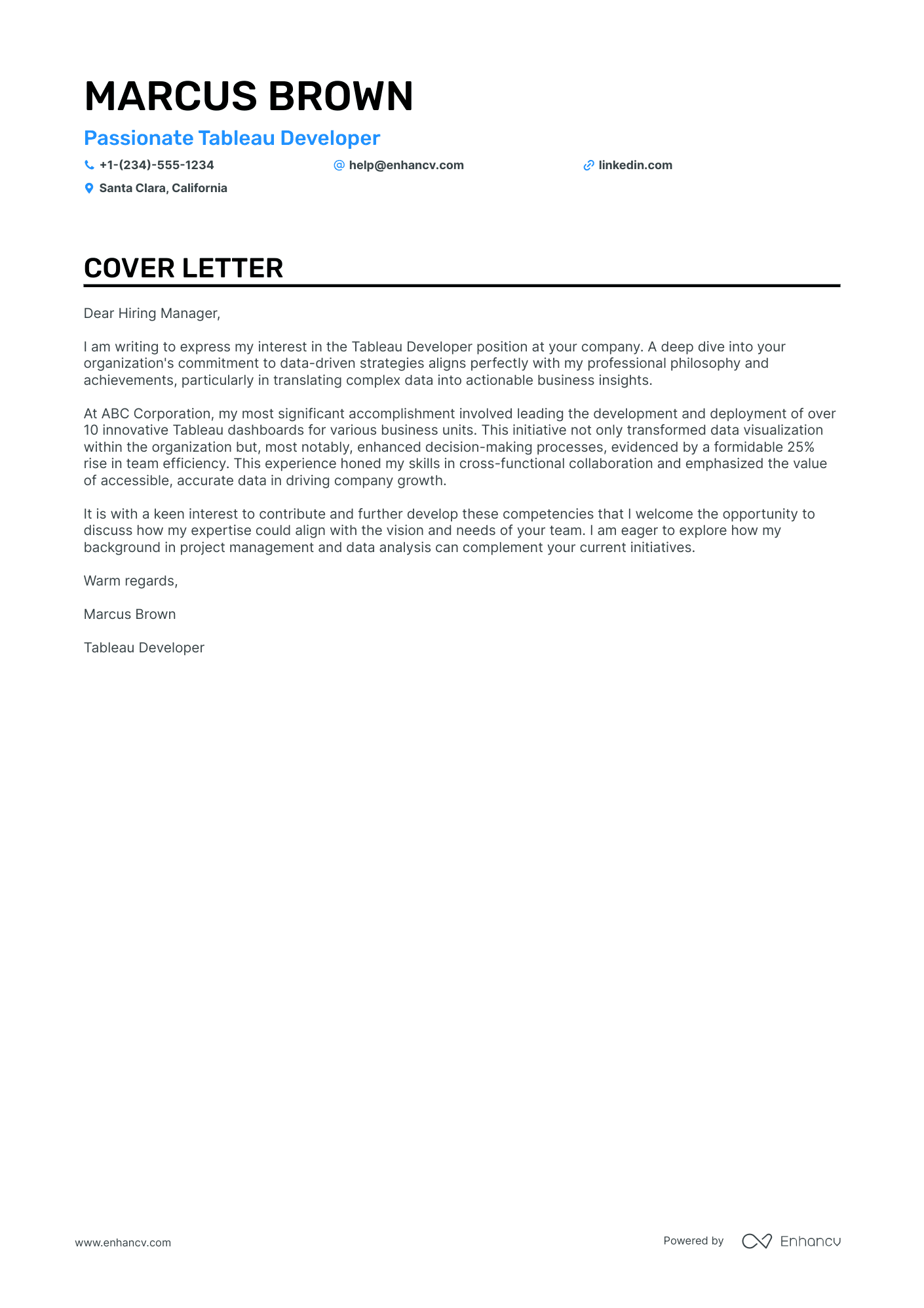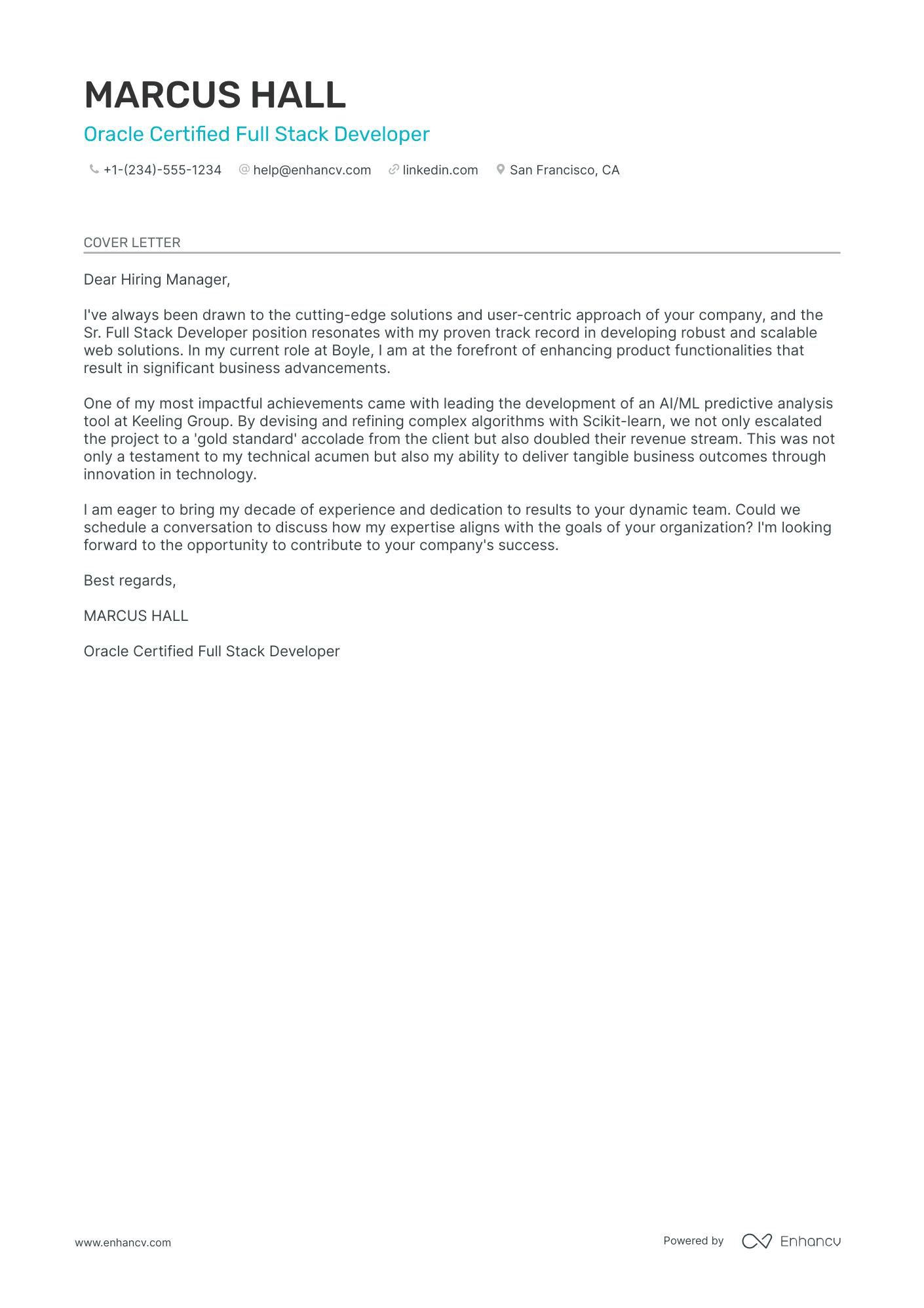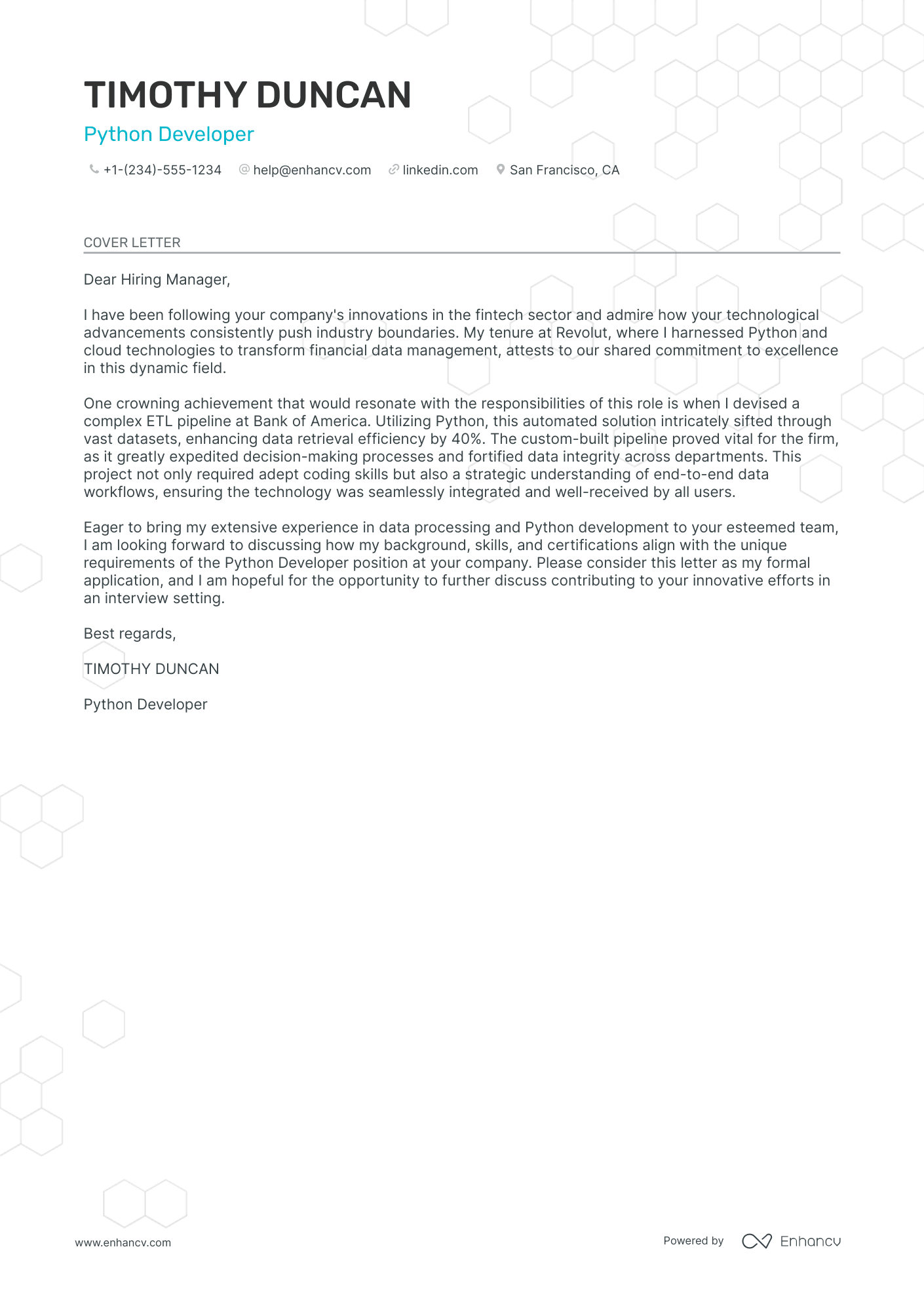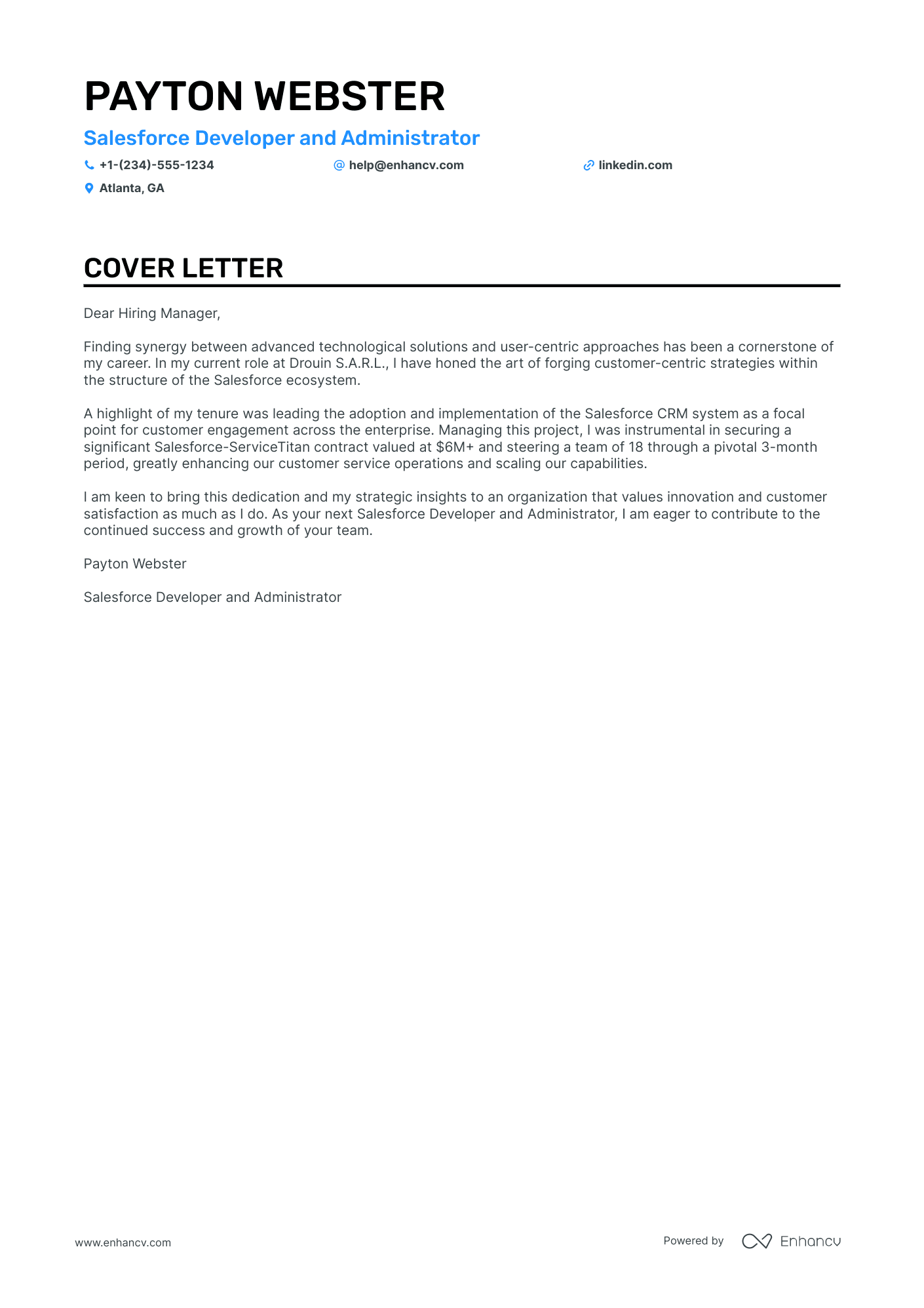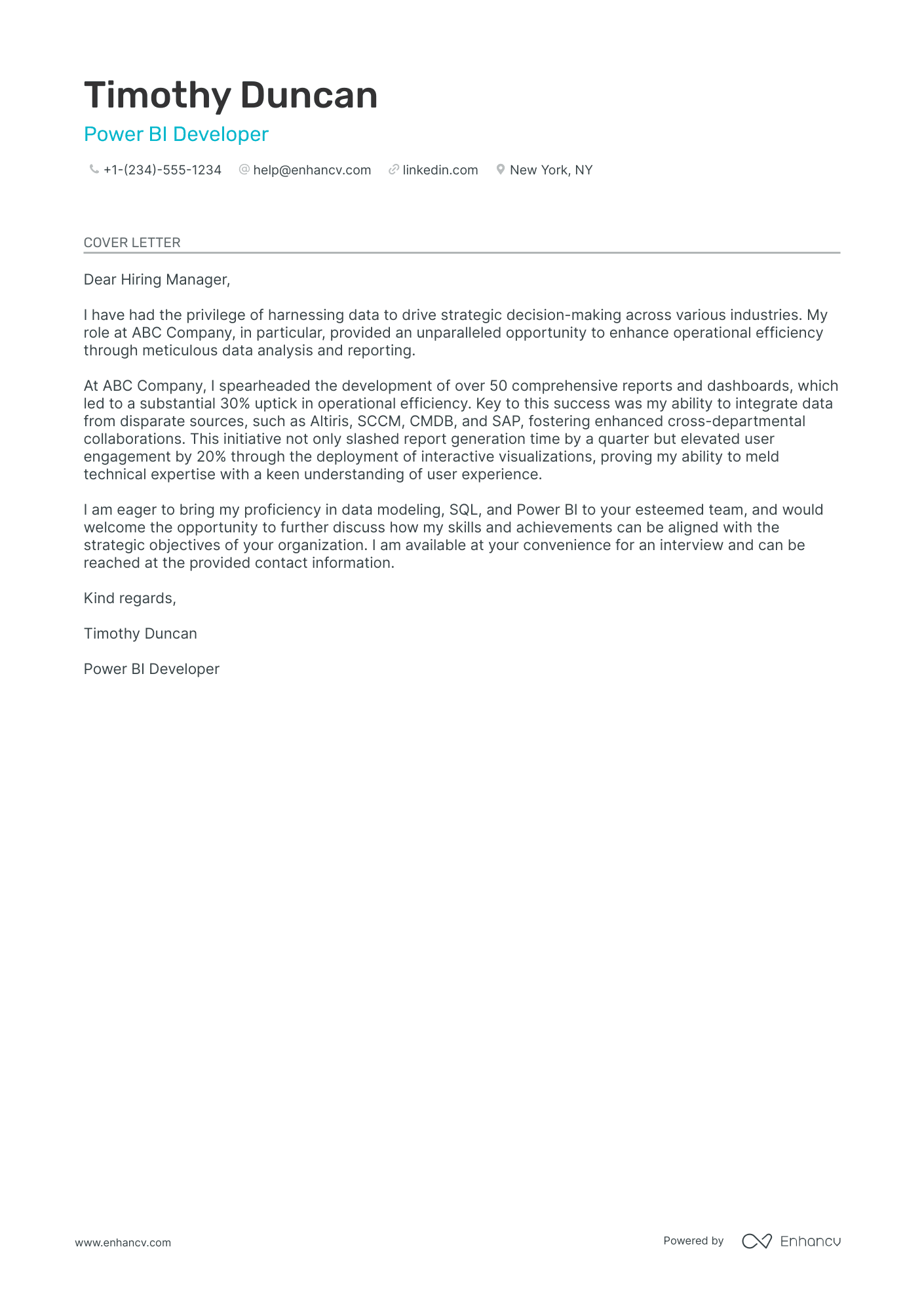Writing a developer cover letter can be daunting, especially if you're already deep in the job hunt and learning that it's an essential part of your application. Your cover letter is a chance to showcase a significant professional triumph, not just echo your resume. It should be a compelling narrative that's formal yet original, steering clear of tired clichés. And remember, brevity is key—aim to make a powerful impression within just one page.
- Making excellent use of job-winning real-life professional cover letters;
- Writing the first paragraphs of your developer cover letter to get attention and connect with the recruiters - immediately;
- Single out your most noteworthy achievement (even if it's outside your career);
- Get a better understanding of what you must include in your developer cover letter to land the job.
Let the power of Enhancv's AI work for you: create your developer cover letter by uploading your resume.
If the developer isn't exactly the one you're looking for we have a plethora of cover letter examples for jobs like this one:
- Developer resume guide and example
- PhP Developer cover letter example
- QA Tester cover letter example
- Database Analyst cover letter example
- Entry-Level Computer Science cover letter example
- Angular Full Stack Developer cover letter example
- Google cover letter example
- AWS Devops cover letter example
- Product Support Specialist cover letter example
- Hardware Engineer cover letter example
- Computer Science cover letter example
Drop your resume here or choose a file.
PDF & DOCX only. Max 2MB file size.
Developer cover letter example
Liam Johnson
Seattle, Washington
+1-(234)-555-1234
help@enhancv.com
- Emphasize relevant project experience: The candidate's mention of leading a cross-functional team to successfully overhaul a core web application directly demonstrates hands-on experience managing and executing high-impact tech projects, which is critical for a Junior Developer role.
- Quantify achievements: Providing specific metrics, such as improving application performance by 30% and reducing QA cycle times by 20%, effectively showcases the candidate's impact on previous projects, underlining the ability to deliver measurable results, a valuable trait in any technical position.
- Show cultural fit: Expressing admiration for the company's culture and innovation in the industry indicates that the applicant has done their research and is genuinely interested in contributing to the company's vision, which can be a persuasive factor in the decision-making process.
- Highlight Agile methodology: Mentioning Agile experience is important for the Junior Developer role, as it's a widely-used framework in software development that emphasizes flexibility, collaboration, and speed—skills that are in high demand.
What about your developer cover letter format: organizing and structuring your information
Here is one secret you should know about your developer cover letter assessment. The Applicant Tracker System (or ATS) won't analyze your cover letter.
You should thus focus on making an excellent impression on recruiters by writing consistent:
- Header
- Greeting
- Introduction
- Body paragraphs (and explanation)
- Promise or Call to action
- Signature (that's optional)
Now, let's talk about the design of your developer cover letter.
Ensure all of your paragraphs are single-spaced and have a one-inch margins on all sides (like in our cover letter templates).
Also, our cover letter builder automatically takes care of the format and comes along with some of the most popular (and modern) fonts like Volkhov, Chivo, and Bitter.
Speaking of fonts, professionals advise you to keep your developer cover letter and resume in the same typography and avoid the over-used Arial or Times New Roman.
When wondering whether you should submit your developer cover letter in Doc or PDF, select the second, as PDF keeps all of your information and design consistent.
Don’t stress about writing your cover letter. Use our free cover letter generator to make one in seconds.
The top sections on a developer cover letter
- Header: Include your contact information and the date, making it easy for the recruiter to know who you are and how to reach you.
- Greeting: Personalize the greeting by addressing the hiring manager directly, if possible, to demonstrate your attention to detail and interest in the position.
- Introduction: Clearly state the position you’re applying for, how you found out about the job, and a brief overview of your relevant experience and skills.
- Body: Elaborate on your technical experience, specific projects, and accomplishments that highlight your suitability for the developer role, showing how you can contribute to the team and the company.
- Closing: Summarize your enthusiasm for the role, reiterate your fit for the job, and include a call to action, like requesting an interview or discussing how you can contribute to future projects.
Key qualities recruiters search for in a candidate’s cover letter
Proficiency in relevant programming languages (e.g., Java, Python, C#): Demonstrates the technical skills necessary for software development tasks.
Experience with software development methodologies (e.g., Agile, Scrum, TDD): Shows an understanding of teamwork and project management in a software development context.
Strong understanding of computer science fundamentals (e.g., algorithms, data structures, databases): Indicates a solid foundation necessary for writing efficient and effective code.
Familiarity with version control systems (e.g., Git): Essential for collaborating on code within a team and managing changes to the codebase.
Problem-solving skills and logical thinking: Critical for debugging issues and designing solutions to complex programming challenges.
Experience with software testing and quality assurance: Highlights a commitment to delivering reliable and maintainable code, which is critical for successful software projects.
Kick off your developer cover letter: the salutation or greeting
When writing your developer cover letter, remember that you're not writing for some complex AI or robot, but for actual human beings.
And recruiters, while on the lookout to understand your experience, would enjoy seeing a cover letter that is tailored to the role and addresses them. Personally.
So, if you haven't done so, invest some time in finding out who's the hiring manager for the role you're applying to. A good place to start would be LinkedIn and the corporate website.
Alternatively, you could also get in touch with the company to find out more information about the role and the name of the recruiter.
If you haven't met the hiring manager, yet, your developer cover letter salutation should be on a last-name basis (e.g. "Dear Mr. Donaldson" or "Dear Ms. Estephan").
A good old, "Dear HR Professional" (or something along those lines) could work as your last resort if you're struggling to find out the recruiter's name.
List of salutations you can use
- Dear Hiring Manager,
- Dear [Company Name] Team,
- Dear [Department Name] Hiring Team,
- Dear Mr./Ms. [Last Name],
- Dear [First Name] [Last Name],
Using your developer cover letter intro to show your dedication
We know just how difficult it is to start writing your developer cover letter introduction.
There are so many great qualities you have as a professional, which one should you choose?
How about writing up to two sentences about your passion and commitment to the work you do or are set to do?
Try to describe exactly what you enjoy about the potential role.
A positive attitude from the get-go will help you stand out as a motivated developer professional.
What to write in the middle or body of your developer cover letter
Here's where it gets tricky.
Your developer cover letter body should present you in the best light possible and, at the same time, differ from your resume.
Don't be stuck in making up new things or copy-pasting from your resume. Instead, select just one achievement from your experience.
Use it to succinctly tell a story of the job-crucial skills and knowledge this taught you.
Your developer cover letter is the magic card you need to further show how any organization or team would benefit from working with you.
Finishing off your developer cover letter with what matters most
So far, you've done a fantastic job in tailoring your developer cover letter for the role and recruiter.
Your final opportunity to make a good impression is your closing paragraph.
And, no, a "Sincerely yours" just won't do, as it sounds too vague and impersonal.
End your developer cover letter with the future in mind.
So, if you get this opportunity, what do you plan to achieve? Be as specific, as possible, of what value you'd bring to the organization.
You could also thank recruiters for their interest in your profile and prompt for follow-up actions (and organizing your first interview).
What to write on your developer cover letter, when you have zero experience
The best advice for candidates, writing their developer cover letters with no experience, is this - be honest.
If you have no past professional roles in your portfolio, focus recruiters' attention on your strengths - like your unique, transferrable skill set (gained as a result of your whole life), backed up by one key achievement.
Or, maybe you dream big and have huge motivation to join the company. Use your developer cover letter to describe your career ambition - that one that keeps you up at night, dreaming about your future.
Finally, always ensure you've answered why employers should hire precisely you and how your skills would benefit their organization.
Key takeaways
Writing your developer cover letter doesn't need to turn into an endless quest, but instead:
- Create an individual developer cover letter for each role you apply to, based on job criteria (use our builder to transform your resume into a cover letter, which you could edit to match the job);
- Stick with the same font you've used in your resume (e.g. Raleway) and ensure your developer cover letter is single-spaced and has a one-inch margin all around;
- Introduce your enthusiasm for the role or the company at the beginning of your developer cover letter to make a good first impression;
- Align what matters most to the company by selecting just one achievement from your experience, that has taught you valuable skills and knowledge for the job;
- End your developer cover letter like any good story - with a promise for greatness or follow-up for an interview.
Developer cover letter examples
By Experience
Senior Developer
Entry Level Developer
Developer Intern
Lead Software Developer
- Highlighting Leadership Experience: The candidate effectively showcases their leadership role in guiding a team at a major company, which is crucial for a Lead Software Developer position.
- Demonstrating Impactful Achievements: By mentioning the specific outcome of increasing user engagement by 25%, the candidate quantifies their contribution, making their impact tangible.
- Technical Proficiency: Elaborating on a specific technical improvement, such as the implementation of a new caching mechanism, highlights the candidate's problem-solving skills and expertise in Swift.
- Alignment with Company Values: The candidate aligns their personal passions with the company's goals, indicating a strong fit with the company's culture and mission.
By Role



